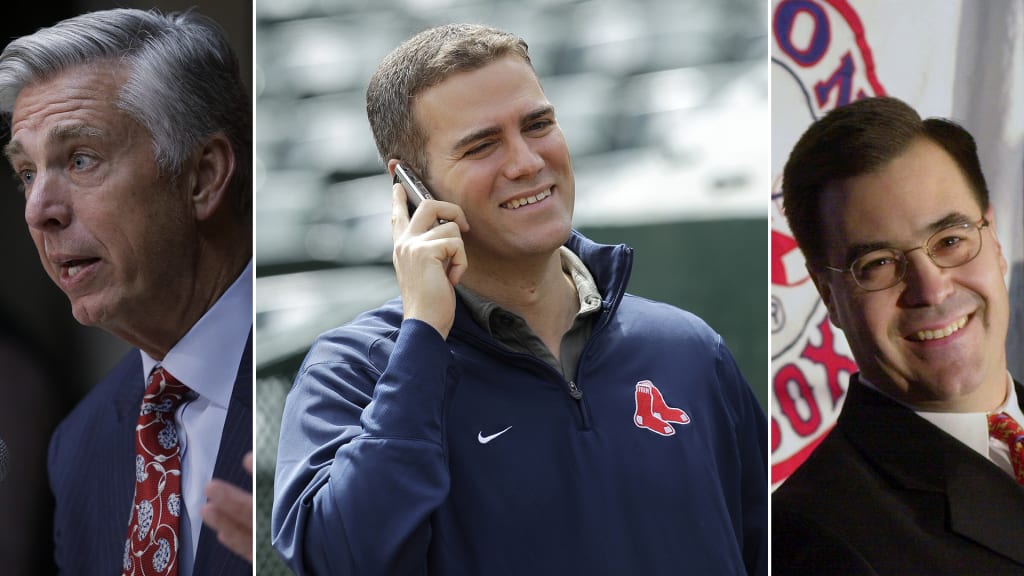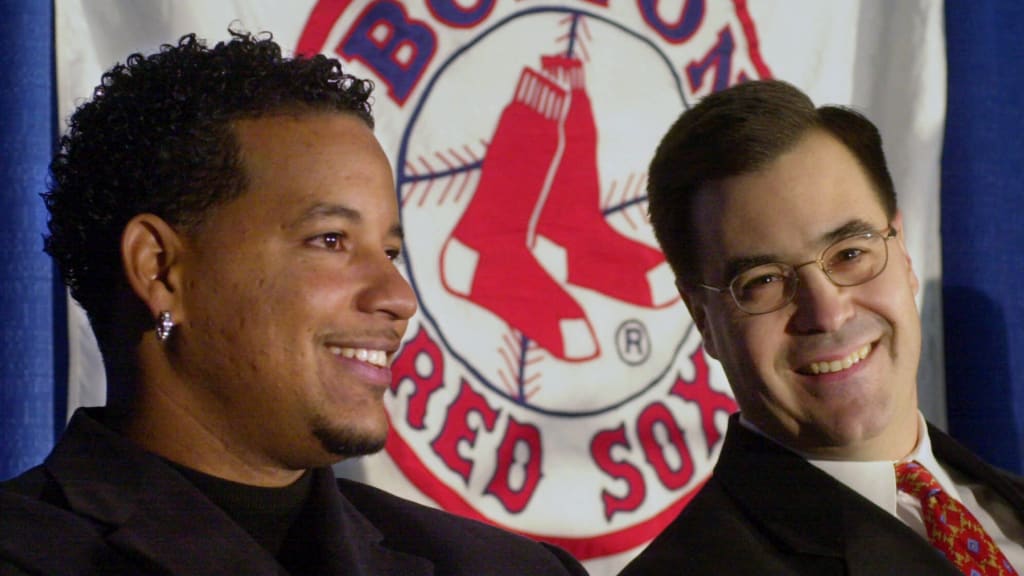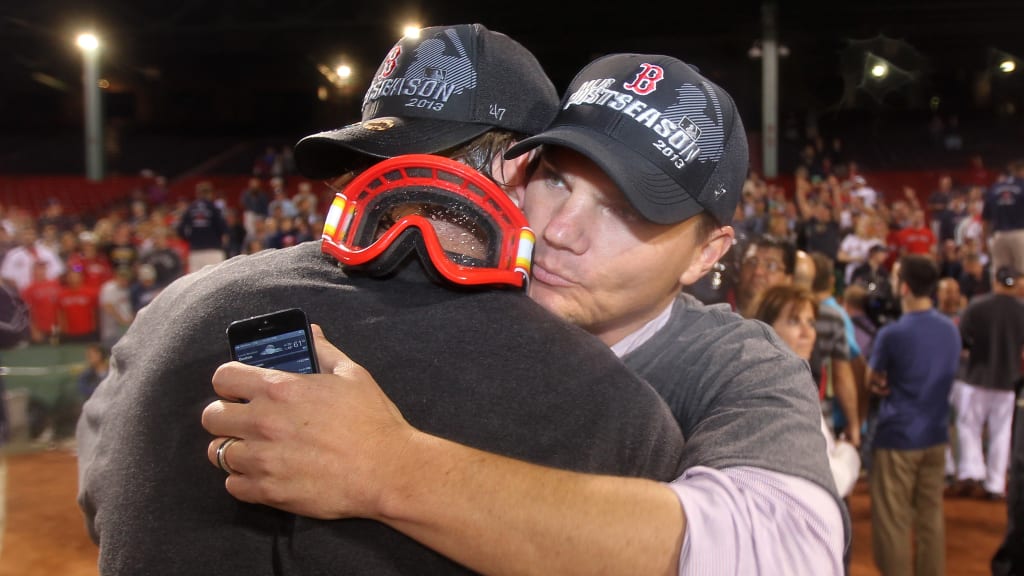
No one loves a good debate quite like baseball fans, and with that in mind, we’ve asked each of our beat reporters to rank the top general managers in the history of their franchise, based on their time guiding that club. These rankings are for fun and debate purposes only … if you don’t agree with the order, participate in the Twitter poll to vote for your favorite at this position.
Below is Ian Browne’s ranking of the top 5 GMs in Red Sox history.
1) Theo Epstein, 2003-11
Key fact: Became the youngest GM in history when hired on Nov. 25, 2002, at age 28
As anyone who saw the movie “Moneyball” knows, the Red Sox pushed hard in that 2002-03 offseason to hire Billy Beane to run their front office. In fact, the Red Sox thought the deal was done, but Beane got cold feet. Boston then decided to get even bolder, giving the young Epstein the chance to run the show. As someone who grew up less than two miles from Fenway Park, this was a thrilling opportunity for Epstein, and he thrived in it.
At his introductory press conference, Epstein vowed to turn the Red Sox into a scouting and player development machine. He wound up fulfilling that mission, but not before he put the finishing touches on the talented roster he inherited and turned the Sox into champions. Exploiting inefficiencies in the market, Moneyball-style, Epstein added Kevin Millar, Bill Mueller and a platoon player named David Ortiz on low-risk, high-reward deals. The Red Sox came five outs away from reaching the World Series in Epstein’s first season on the job.
Epstein went right back to work, giving up his Thanksgiving holiday to acquire Curt Schilling and then signing the closer the Red Sox needed in Keith Foulke. He also hired the perfect manager for that team in Terry Francona. The result? A 2004 World Series championship squad, Boston’s first in 86 years. Behind Epstein’s newly constructed scouting and player development machine, the Red Sox again won it all in '07 with young players like Dustin Pedroia, Jacoby Ellsbury, Jon Lester and Jonathan Papelbon all playing pivotal roles. The Sox reached the postseason six times in Epstein’s nine seasons in Boston.
2) Dick O’Connell, 1965-77
Key fact: Architect of pennant-winning teams of 1967 and ‘75
One of the first key moves that O’Connell made during his regime was promoting Minor League manager Dick Williams to that position in Boston. In his first year, Williams helped guide the Red Sox to their Impossible Dream pennant of 1967. O’Connell made in-season trades for Gary Bell, Jerry Adair and Elston Howard to give the Sox the depth they needed.
Under O’Connell’s watch in the 1970s, the Red Sox developed an elite farm system that produced players like Carlton Fisk, Jim Rice, Dwight Evans, Fred Lynn, Rick Burleson, Cecil Cooper, Ben Oglivie and Juan Beniquez. He also signed Luis Tiant after the charismatic righty had been released to the Braves. Backed by Tiant and a collection of stud position players, O’Connell’s Red Sox won the pennant in ‘75, sweeping the three-time defending champion Athletics in the American League Championship Series. They went toe to toe with the Big Red Machine Reds in the World Series, but ultimately lost by one run in Game 7.
With the roster that O’Connell assembled, Boston was a perennial contender in the mid to late 1970s. The one blemish on O’Connell’s résumé is that the Red Sox never won a World Series during his regime. But they sure did come close.
3) Dave Dombrowski, 2015-19
Key fact: Oversaw three AL East titles in his three full seasons with Boston
Much like Epstein 13 years earlier, Dombrowski inherited a strong core of talent when he was hired to run Boston’s baseball operations department in August 2015. The difference is that the roster Epstein took over was loaded with veterans, while Dombrowski’s squad had young talent ready to emerge into stars. He also had franchise icons Ortiz and Pedroia, which certainly helped.
Dombrowski’s job was to find a way to put that team over the top, so he was aggressive in acquiring premium pitching. His first move was the acquisition of Craig Kimbrel from the Padres. Dombrowski then signed David Price to a record-setting deal at the time for a starting pitcher -- seven years at $217 million. Those additions helped propel the Sox to the AL East title in 2016. Dombrowski doubled down for another elite pitcher that next offseason when he traded blue-chip prospects Yoán Moncada and Michael Kopech for an ace in his prime in Chris Sale. Though the Red Sox struggled offensively following the retirement of Ortiz, Dombrowski’s squad again won the AL East in ’17, only to lose to the Astros in the AL Division Series.
But something huge happened at the end of February 2018, when Dombrowski snagged free-agent slugger J.D. Martinez to essentially replace Ortiz. With all the pieces now in place, the Red Sox roared through the ’18 season, notching a franchise-record 108 wins. Dombrowski made a key in-season addition with the right-handed bat of Steve Pearce, who would go on to win the World Series Most Valuable Player Award. The Red Sox dominated a talented postseason field (Yankees, Astros and Dodgers) with an 11-3 mark for its fourth World Series title in 15 seasons.
The one negative part of Dombrowski’s tenure was that he left the payroll in an unenviable spot, which played at least some role in the Red Sox trading superstar Mookie Betts. After the 2018 World Series, owner John Henry wanted to start re-prioritizing the farm system. But Dombrowski remained in more of a win-now mindset, which is why the organization opted to let him go late in the ’19 season.
4) Dan Duquette, 1994-2002
Key fact: Acquired the great Pedro Martinez twice in his career -- first as the GM of the Expos and then later with the Sox
Duquette took over a franchise that had fallen on hard times in the early 1990s and built them back from the ground up. The first Draft pick of the Duquette era in Boston? Nomar Garciaparra. By 1995, Duquette’s second season at the helm, the Red Sox won the AL East. Duquette picked knuckleballer Tim Wakefield up off the scrap heap after he had been released by the Pirates. All Wakefield did upon arrival was go 14-1 with a 1.65 ERA in his first 17 starts. He wound up as a cornerstone player for the Red Sox through 2011. Duquette found another unheralded player for ’95 who would become a key part of the team’s success in outfielder Troy O’Leary.
After a bump in the road in 1996 and ’97, Duquette had the Red Sox back in the postseason in ’98 and ’99. A major reason for this was his acquisition of Martinez in what proved to be a steal from the Expos. The Red Sox sent over two Minor League righties in Carl Pavano and Tony Armas Jr.
Duquette’s fingerprints were all over Boston’s championship squad of 2004. His trade of Heathcliff Slocumb for Jason Varitek and Derek Lowe is easily one of the top five in Sox history. Duquette also got aggressive on the free-agent market, signing Manny Ramirez to an eight-year, $160-million deal in December 2000. And right before Duquette was let go in February ’02, he made the key free-agent signing of center fielder Johnny Damon. Though Duquette’s people skills weren’t always the best in Boston -- which he later admitted -- his good moves far outweighed his bad.

5) Ben Cherington, 2012-15
Key fact: Played key role as Boston’s farm director before becoming GM
How did we pick a GM in the top five who had three last-place finishes in three years on the job? It’s complicated, but Cherington was a strong executive who led the club to perhaps its most unlikely World Series title in 2013. He set the foundation for that with a brilliant post-waiver deal with the Dodgers in ’12 in which he unloaded the salaries of Adrián González, Carl Crawford and Josh Beckett.
Cherington didn’t get much of note back from Los Angeles in player compensation, but he created the financial freedom that led to the signings of Mike Napoli, Koji Uehara, Shane Victorino, Jonny Gomes, David Ross and Ryan Dempster -- all of whom were significant in that Boston Strong title.
In his role as farm director, Cherington set the Red Sox up nicely for their title in 2007 with his nurturing of a system that included prospects Pedroia, Papelbon, Lester and Ellsbury. And he helped make the ’18 title possible by leaving Dombrowski with some ready-made young contributors like Betts, Jackie Bradley Jr., Xander Bogaerts and Eduardo Rodriguez.
The moves that shortened Cherington’s tenure in Boston were pretty straightforward: He was unable to reach an agreement on a contract extension with Jon Lester, even after the lefty stated he would take a hometown discount. Cherington instead wound up trading Lester to Oakland and fell short to the Cubs when he tried to get him back as a free agent. The other moves that haunted him: The free-agent signings of Pablo Sandoval and Hanley Ramirez.

Honorable mentions
• Eddie Collins led the front office from 1933-47 and signed a couple of guys you might have heard of: Ted Williams and Bobby Doerr. Collins also acquired Jimmie Foxx and Lefty Grove and built up the pitching staff to the point of turning the Red Sox into pennant winners in ’46.
• The late Lou Gorman probably goes down as the friendliest GM in Sox history. He also made some savvy moves to set up the 1986 pennant, trading for Don Baylor just prior to the season and getting postseason hero Dave Henderson along with Spike Owen in an August deal with the Mariners. He later dealt Al Nipper and Calvin Schiraldi for closer Lee Smith, setting up the 1988 AL East title. Gorman’s Red Sox won the AL East three times in five seasons, capturing another in ’90.


